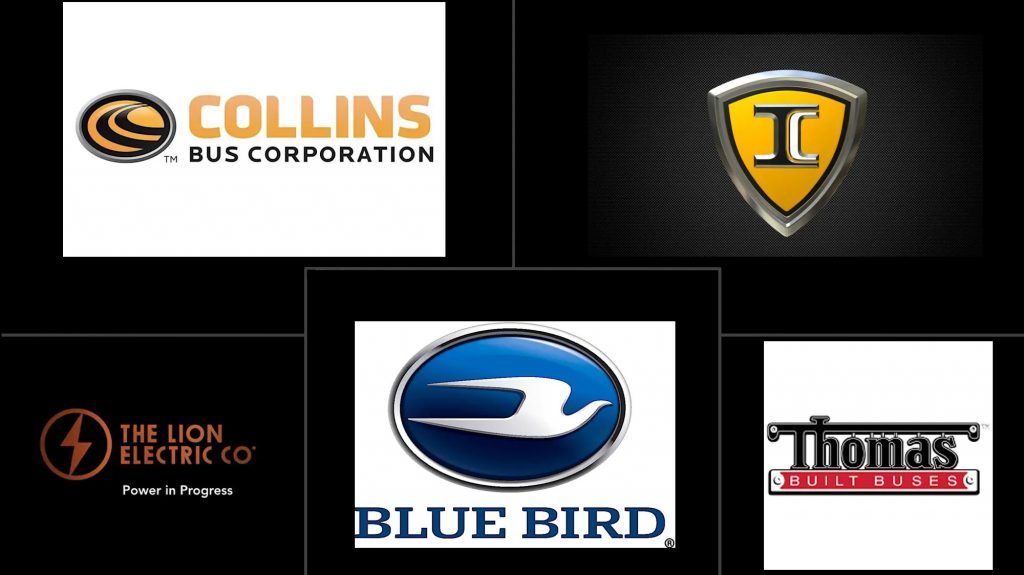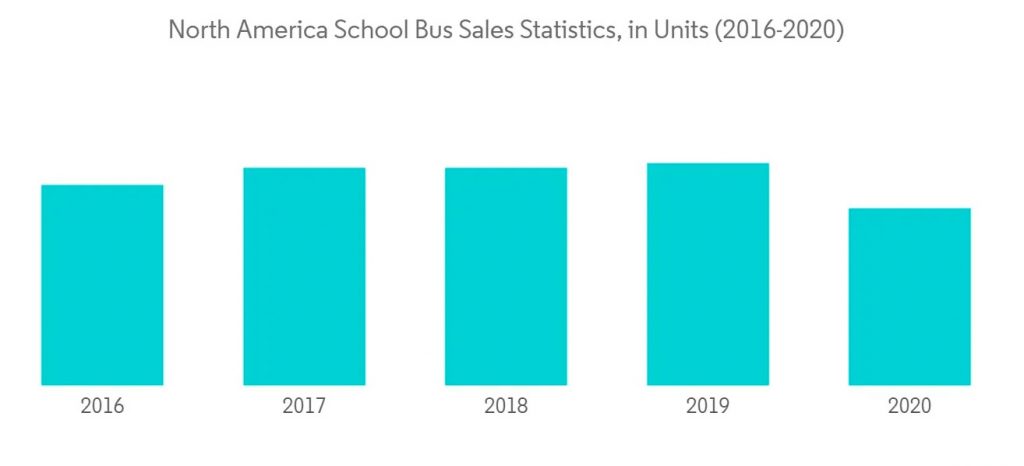NORTH AMERICA SCHOOL BUS MARKET FORECASTS (2021 – 2026)
NORTH AMERICA SCHOOL BUS MARKET – GROWTH, TRENDS, COVID-19 IMPACT, AND FORECASTS (2021 – 2026)
The North America School Bus Market is segmented by Power-train (IC Engine and Electric), Bus Type (Type C, Type D, and Other Types), and by Country.
Study Period: 2018 – 2026
Base Year: 2020
CAGR: >4 %

The North America School Bus Market was valued at USD 1.5 billion in 2020 and is expected to reach USD 2.7 billion by 2026, and is anticipated to register a CAGR of over 4% during the forecast period (2021 – 2026).
The outbreak of the COVID-19 coronavirus has disrupted schools, businesses, and transportation across North America. The COVID-19 pandemic hit student transportation with school closures. Add to that high unemployment numbers that are leading to lower tax revenues to support schools, which in turn shrink district budgets, making it tough for them to purchase new buses.
Stringent emission norms have pushed the demand for alternative fuel-powered vehicles. The adoption of electric vehicles in the commercial vehicle segment has influenced the school bus segment, which is expected to drive the North American school bus market during the forecast period. The advantage of school buses over other modes of transport is also one of the reasons that will help the growth of the market. School buses are generally built with high crash standards, protective seating, rollover protection, large windows for increased visibility, and other features such as distinct paint color (in some regions), flashing lights.
In North America, school buses are purpose-built vehicles distinguished from other types of buses by design characteristics mandated by federal and state/province regulations. In addition to their distinct paint color (school bus yellow), school buses are fitted with exterior warning lights to give them traffic priority and multiple safety devices. In the major North American countries, school transport is very organized and has been in existence for many decades. Hence, demand has been stable for the past few years and is expected to be similar over the forecast period.
The market is mostly dominated by players from US and Canada. IC engine buses are expected to have a larger share whereas electric school buses are expected to be the fastest growing segment. Type C and Type D buses are the most popular ones followed by others such as Type A.
The North America School Bus Market has been segmented on the basis of powertrain, bus type, and country.
By powertrain, the segment is divided as IC Engine and Electric. By Bus Type, the segment is divided as Type C, Type D, and Others. By Country, the segment is divided as the United States, Canada, and the Rest of North America.
| Powertrain | |
| IC Engine | |
| Electric |
| Bus Type | |
| Type C | |
| Type D | |
| Other Types |
| Country | |
| United States | |
| Canada | |
| Rest of North America |
Industry’s Shift Towards the Adoption of Electric School Bus
In many developed and developing nations, school buses play an integral role in transporting students saving a considerable amount of money for parents, and reducing traffic on the roads in a way. It is estimated that a school bus replaces around 36 cars on the road in developed nations like the United States.
In a development likely related to the pandemic, 2020 sales numbers include a particularly sharp decline (about 26%) in Type A (small) bus sales, for a total of 7,200. This could be due to the fact that sales of that bus type have been especially high for years coupled with the need many districts and school bus companies now have for more large school buses to better accommodate social distancing. North American school bus sales saw a significant dip due to the pandemic. In the 2020 sales year, they were down just over 20% from 2019.
More than 95% of the school buses in the countries run on fossil fuels, especially diesel. Numerous studies worldwide have shown that inhaling diesel exhaust causes respiratory diseases and will worsen existing conditions like asthma. These negative effects are pronounced especially in children who are the main commuters. Replacing all the school buses of only America itself with electric buses could avoid an average of 5.3 million tons of greenhouse gas emissions each year.
Electric buses are becoming an increasing option in place of conventional diesel buses. Electric buses give out zero emissions and their annual operating cost is almost half of a diesel bus. Hence, many cities and districts in the country are exploring electric school buses. California has been at the forefront in adoption of electric school buses. The first all-electric school bus took to the roads back in 2014. This bus featured an electric powertrain derived from Motiv power systems. In 2018, California ordered 40 eLion school buses which were delivered to 12 districts across the state. Recently in 2019, California is planning to replace 200 polluting school buses with electric ones and is in plans to offer a funding of nearly USD 70 million for the same.
Electric school bus sales continue to hold steady and interest in adding them to fleets is apparently increasing. In 2019, electric school buses comprised just less than 1% of school buses purchased, and manufacturers reported the same number for 2020, once again outpacing compressed natural gas (CNG) sales.

United States to grow at a high rate
The school bus market in the united states is expected to grow at a rate of more than 4% over the next five years. The number of new school buses in the country has been increasing since 2012 (post-recession) and in 2019, there were 40,714 sales which is very high as compared to other countries in the region like Canada where 4,607 sales were registered in 2019.
Most state governments in the US generally require their district schools to provide transportation to and from schools. Each school district has two options to provide transportation service to its students. Under the first option, the school assumes the responsibility of providing transportation itself. The district school buys and maintains the equipment, sets the routes, and covers all other functions. The second option is to award a contract to a private student transportation provider. Private companies transport approximately one-third of the country’s schoolchildren.
Many regional manufacturers are working with technology companies to develop new and innovative products which in turn is driving the competition and market. Daimler has invested US$ 155 million in electric bus maker Proterra, with an aim of accelerating the development of electric commercial vehicles. The first product of this association between the two companies is an electric school bus from Daimler’s Thomas Built Bus division. In June 2019, Thomas Built Buses received full California Air Resources Board (CARB) and Hybrid and Zero-Emission Truck and Bus Voucher Incentive Project (HVIP) certificates for its Type C electric bus, the Saf-T-Liner C2 Jouley which is powered by Proterra electric vehicle technology. According to the company this certification officially qualifies the bus model for state vouchers.
Competitive Landscape
The market for North American school buses is a consolidated one. The region is characterized by the presence of major school bus manufacturers who also cater to other countries. Blue Bird Corporation, IC Bus, Thomas Built Buses Inc. are the three main players who are expected to occupy a major share of the market. Other major companies are Collins Bus Corporation, Micro Bird, and Lion Electric company. Moreover, companies are introducing new features in their products to increase their market share.
For instance, In February 2020, Thomas Built Buses showcased the Auto-Reversing Door feature for the company’s school bus portfolio. According to the company, the first-of-its-kind feature is available on all versions of the Saf-T-Liner C2 school bus and allows the front entry doors to reopen automatically if they sense an object or obstruction in the doorway. In operation, an audible alarm will sound, and the doors will automatically reverse motion to return to the fully open position. Moreover, the company is developing a prototype of new pedestrian detection technology in partnership with MITO Corporation and CUB Group to prevent pedestrian accidents outside of the school bus.
Major Players
Recent Developments
- US school bus manufacturer Blue Birds has announced that it has registered a +250% in sales of e-buses in 2020 and therefore announces a strategy to increase production capacity up to 1,000 units annually. making nearly 50 percent of Blue Bird’s bus sales are non-diesel powered.
- Lion Electric Company announced the construction of a battery manufacturing plant and innovation center in Quebec. Utilizing cutting-edge technology, the factory is planned to begin operations in early 2023 and will produce battery packs and modules made from Lithium-ion cells.
- 2021 Congress approved a second pandemic relief bill with $81.9 billion dedicated to help support educational institutions – including a $1.3 billion Emergency Education Relief Fund (GEER), and a $54.3 billion Elementary and Secondary Emergency Relief Fund (ESSER).GEER and ESSER funds could be used to help your school district invest in new technology to support social distancing initiatives, help ease school bus routing challenges, better protect students outside the bus, enable various hybrid learning models, ensure the proper sanitation of school buses and help you make quick and efficient risk reduction measures to emerging situations as they occur.
- Federal Bill Would Invest $25B in School Bus Fleet Electrification
- The Clean Commute for Kids Act would invest $25 billion to transition a significant portion of the nation’s school bus fleet to electric.

